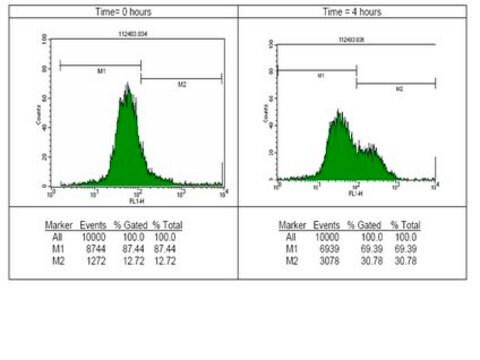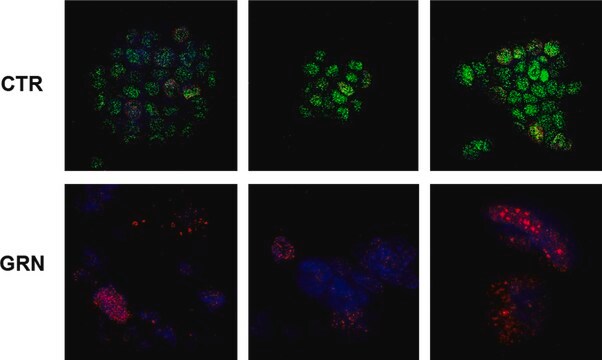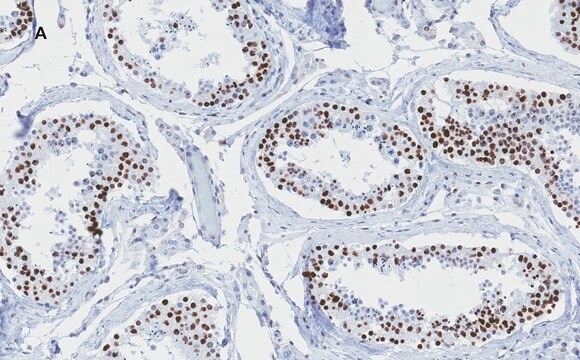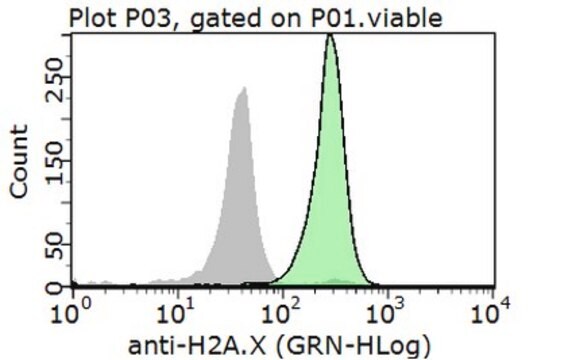07-164-AF647
Przeciwciało anty-fosfo H2A.X (Ser139), koniugat Alexa ™ 647
from rabbit, ALEXA FLUOR™ 647
Synonim(y):
Histon H2A.X, Histon H2A.X, H2a/x
About This Item
Polecane produkty
pochodzenie biologiczne
rabbit
Poziom jakości
białko sprzężone
ALEXA FLUOR™ 647
forma przeciwciała
purified antibody
rodzaj przeciwciała
primary antibodies
klon
polyclonal
reaktywność gatunkowa
human
reaktywność gatunkowa (przewidywana na podstawie homologii)
vertebrates (based on 100% sequence homology)
metody
immunocytochemistry: suitable
izotyp
IgG
numer dostępu NCBI
numer dostępu UniProt
Warunki transportu
wet ice
docelowa modyfikacja potranslacyjna
phosphorylation (pSer139)
informacje o genach
human ... ATP10D(57205) , H2AX(3014)
Opis ogólny
Specyficzność
Immunogen
Zastosowanie
Epigenetyka i funkcje jądrowe
Epigenetyka i funkcje jądrowe
Histony
Biologia chromatyny
Jakość
A 1:100 dilution of this antibody detected phospho Histone H2A.X (Ser139) in HeLa cells.
Alexa Fluor™ is a registered trademark of Life Technologies.
Opis wartości docelowych
Postać fizyczna
Przechowywanie i stabilność
Inne uwagi
Informacje prawne
Oświadczenie o zrzeczeniu się odpowiedzialności
Nie możesz znaleźć właściwego produktu?
Wypróbuj nasz Narzędzie selektora produktów.
Kod klasy składowania
12 - Non Combustible Liquids
Klasa zagrożenia wodnego (WGK)
WGK 2
Temperatura zapłonu (°F)
Not applicable
Temperatura zapłonu (°C)
Not applicable
Certyfikaty analizy (CoA)
Poszukaj Certyfikaty analizy (CoA), wpisując numer partii/serii produktów. Numery serii i partii można znaleźć na etykiecie produktu po słowach „seria” lub „partia”.
Masz już ten produkt?
Dokumenty związane z niedawno zakupionymi produktami zostały zamieszczone w Bibliotece dokumentów.
Nasz zespół naukowców ma doświadczenie we wszystkich obszarach badań, w tym w naukach przyrodniczych, materiałoznawstwie, syntezie chemicznej, chromatografii, analityce i wielu innych dziedzinach.
Skontaktuj się z zespołem ds. pomocy technicznej






![Western Blocking Reagent, Solution solution, sufficient for 10 blots (11921673001 [100 cm2]), sufficient for 60 blots (11921681001 [100 cm2])](/deepweb/assets/sigmaaldrich/product/images/352/091/ef743cea-ccd8-44f1-8f3b-dec5a1e4f5d1/640/ef743cea-ccd8-44f1-8f3b-dec5a1e4f5d1.jpg)

